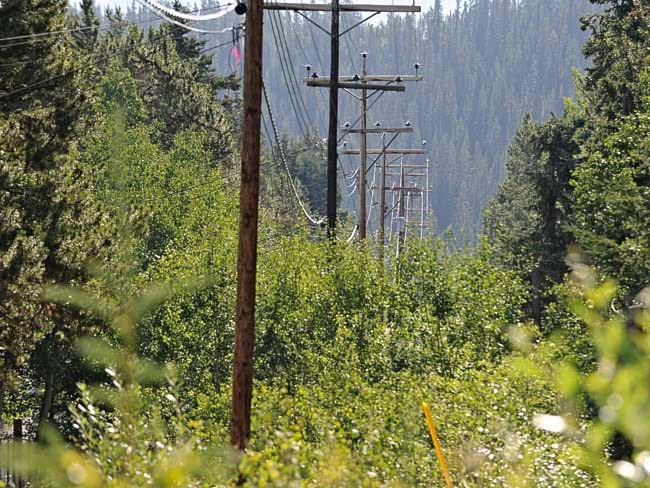UPDATED
Yukon Energy is testing herbicides as a way to control plant growth under power lines.
Currently the corporation hires contractors to clear trees and brush near transmission lines. This is required to prevent fires and maintain a reliable power supply.
But the Yukon Utilities Board has directed Yukon Energy to look at cheaper ways of getting the job done, said president David Morrison.
“The costs of brushing have gotten to be several hundred thousand dollars a year - I think it’s around five or six hundred thousand dollars. It’s a lot of money.
“When we spend ratepayers’ money, we continually look at ways to improve the efficiency of what we’re doing.”
A consultant looked at the problem about a year ago, and recommended using herbicides as part of the brushing program, said Morrison.
Three herbicides are being tested at two 10-by-10-metre plots near Whitehorse.
One of the plots is off the Takhini Hot Springs Road next to the Pilot Mountain subdivision. The other is along Long Lake Road about three kilometres past the lake.
Testing began July 8 and Yukon Energy has asked that people and pets stay out of the well-marked plots through July 22.
The tests will be repeated next summer, said Morrison.
Environment Yukon issued the permits for the tests.
Whether or not the herbicides will go into regular use will depend on the outcome of the tests, he said.
An assessment by the Yukon Environmental and Socio-economic Assessment Board would not be required, since the herbicides are classified as “commercial” by Health Canada, according to a Yukon Energy spokesperson. The chemicals are also available off-the-shelf to individuals for home use.
But a local naturopathic doctor says the herbicide-spraying plan is shortsighted, and could undermine the health of both people and the environment.
“We can come up with solutions that don’t require poison. We can cloak it in euphemistic terms and call them biocides and herbicides or whatever - they’re poison,” said Gordon Smith.
“The decision to proceed is a bit premature, as it doesn’t take into consideration sufficient ecologically-based information regarding either human or ecological health repercussions.”
The herbicides in use are Garlon XRT #28945, Roundup Transorb Liquid Herbicide #28198 and Arsenal, according to a Yukon Energy blog post.
These chemicals were recommended in a report by Environmental Dynamics Inc. as the safest and most appropriate options for the Yukon environment.
“The product we are using is Health Canada approved,” said Morrison. “It’s non-toxic, safe for humans and animals.”
However the EDI report indicates that the herbicides are toxic to aquatic plants and organisms as well as plants not intended as targets.
It recommends very careful handling of the chemicals to prevent environmental harm.
“All mixing, loading and application of herbicides are undertaken in a safe manner, at least 15 metres from, and selected to prevent, any spilled herbicides from entering into pesticide-free zones; no treatment zones; bodies of water; fish or wildlife habitat; water sources; or other environmentally sensitive features,” according to the report.
Best practices on paper will never translate into perfect use in real life, said Smith.
In addition, the environmental assessment far underestimates the toxicity of the herbicides, ignoring the latest research, he said.
A research paper recently published in Toxicology, a leading scientific journal, suggests that Roundup and related herbicides are much more toxic than manufacturers and regulators suggest.
The main ingredient, glyphosate, is the one most studied, but in fact it is additives not always listed on the label that are most potentially harmful to humans and the environment, according to the report.
“The agencies’ opinions are wrong because they are made on the basis of lax assessments and much of the industry data is kept confidential, meaning that a full and transparent assessment cannot be carried out,” concluded the authors of the study.
Regarding the EDI report commissioned for Yukon Energy, Smith noted that toxicological considerations for Roundup were taken straight from the product label, as published by Monsanto Canada.
“This is like trusting the fox to guard the chicken coop, basically,” said Smith.
Yukoner Sue Thomas says we should learn from past mistakes when it comes to spraying chemicals in the environment.
She grew up in Beaver Creek in the 1960s, when the U.S. Army would spray chemicals on a military pipeline between Haines and Fairbanks.
One of the herbicides used was Agent Orange, which has been linked to cancer and diabetes among Vietnam vets, and birth defects among their offspring.
“I recall the plane that used to spray the corridor and we were, as kids, made to stay inside while the plane flew overhead,” said Thomas. “We were told we had to wait half an hour before we could go outside and play.
“We liked to play on the pipeline corridor because there was an eight-inch pipe to walk on, you know, balance like kids do. And that’s where the puddles were, the easy access to the cranberries. It was the corridor we used, never thinking that there was anything harmful about squishing our toes in the mud.”
The chemicals may have been a factor in an immune disorder that took her mother’s life, said Thomas.
She too has health issues related to chemical sensitivity, she said.
Thomas has little faith that the herbicides of today are any better than those of the past, she said.
“In the 1960s they thought the Agent Orange and the DDT, 2,4-D, were safe.
“With what we know today, those chemicals (in use today) are considered safe, but 20 years from now will those still be considered safe?”
Smith, the naturopathic doctor, agrees.
“Our track record for ensuring safety has proven to be pretty disturbingly inadequate and shortsighted, and frankly puts us in dire need of some serious harm reduction strategy.”
Contact Jacqueline Ronson at jronson@yukon-news.com
